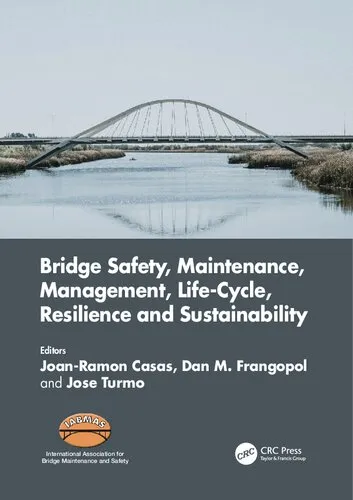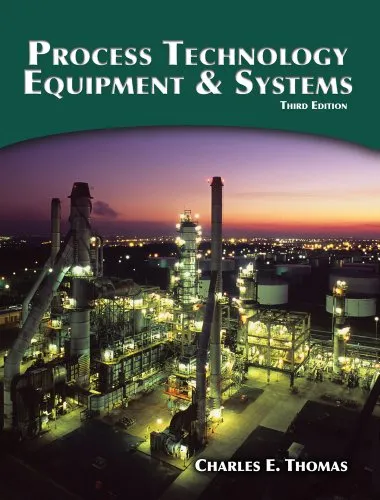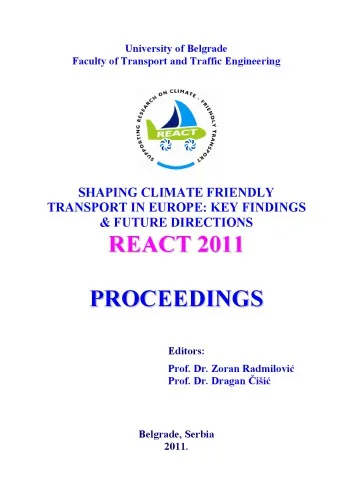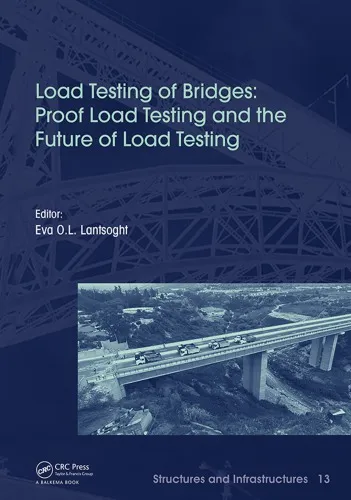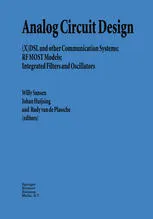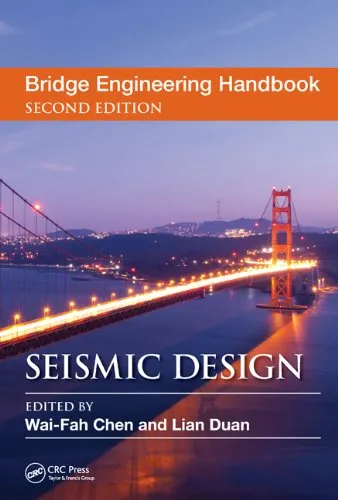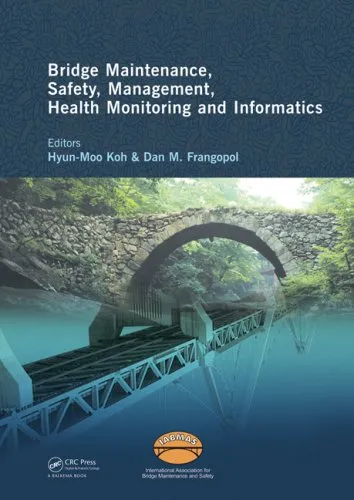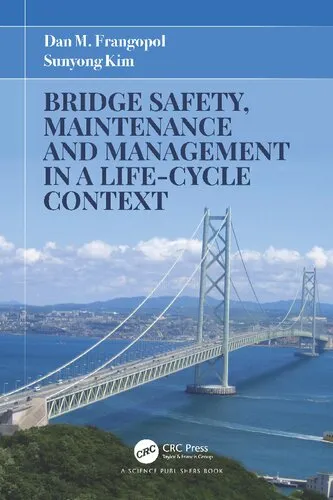Bridge Safety, Maintenance, Management, Life-Cycle, Resilience and Sustainability
4.0
بر اساس نظر کاربران

شما میتونید سوالاتتون در باره کتاب رو از هوش مصنوعیش بعد از ورود بپرسید
هر دانلود یا پرسش از هوش مصنوعی 2 امتیاز لازم دارد، برای بدست آوردن امتیاز رایگان، به صفحه ی راهنمای امتیازات سر بزنید و یک سری کار ارزشمند انجام بدینRelated Refrences:
معرفی کتاب "Bridge Safety, Maintenance, Management, Life-Cycle, Resilience and Sustainability"
کتاب "Bridge Safety, Maintenance, Management, Life-Cycle, Resilience and Sustainability" یک منبع برجسته و جامع در زمینه مهندسی پل و مدیریت چرخهحیات آنها است. این کتاب که توسط Joan-Ramon Casas، Dan M. Frangopol و Jose Turmo تألیف شده است، به بررسی همهجانبه اصول، روشها و چالشهای مدیریت پلها در دنیای مدرن میپردازد. محتوای این اثر بهگونهای تنظیم شده است که قابلیت مطالعه برای مهندسین حرفهای، دانشجویان مهندسی عمران و محققانی که در جستجوی منابع پیشرفته هستند، را دارد.
خلاصهای جامع از کتاب
این کتاب به جنبههای مختلف مدیریت پلها از جمله ایمنی، نگهداری، مدیریت، و چرخه حیات میپردازد. بهطور خاص، تأکید بر اهمیت پایداری و Resilience در طراحی و بهرهبرداری از پلها یکی از نقاط قوت این اثر علمی است. نویسندگان، مسائل مربوط به ناکارآمدی زیرساختها و چگونگی مقابله با تغییرات آبوهوایی و بلایای طبیعی را بررسی میکنند و رویکردهای پیشرفتهای را برای بهبود طراحی و ساختار پلها ارائه میدهند. همچنین، اصول Life-Cycle Cost Analysis (LCCA) و مدیریت ریسک بهصورت کامل توضیح داده شده است. این کتاب با ترکیبی از تئوری، مثالهای کاربردی و مطالعات موردی در دنیای واقعی، دانش مناسبی را به خوانندگان ارائه میدهد.
نکات کلیدی کتاب
- بررسی عوامل مؤثر بر ایمنی پلها و روشهای کاهش ریسک.
- استفاده از ابزارهای مدرن نظیر Digital Twin برای طراحی و نگهداری پلها.
- روشهای نوین در ارزیابی چرخهحیات پلها و تصمیمگیریهای بهینهسازی هزینهها.
- تأکید بر اهمیت پایداری زیستمحیطی و نقشهراه توسعهی زیرساختهای پایدار.
- آشنایی با ابزارهای تحلیل احتمالی (Probabilistic Analysis) و کاربردهای آن در طراحی و مدیریت پلها.
جملات معروف از کتاب
“Bridges are not just structures of steel and concrete; they are critical links that facilitate economic development and connect communities.”
“Integrating sustainability and resilience in bridge management is no longer an option; it's a necessity.”
“A well-maintained bridge tells a story of foresight, resilience, and commitment to long-term value.”
چرا این کتاب مهم است؟
کتاب "Bridge Safety, Maintenance, Management, Life-Cycle, Resilience and Sustainability" بهدلیل نگرش جامع و کاربردی خود به مسائل مدیریت و مهندسی پلها، به یکی از منابع اصلی مهندسان عمران و مدیران زیرساخت تبدیل شده است. اهمیت این کتاب تنها محدود به اهمیت پلها بهعنوان ساختارهای اصلی حملونقل نیست، بلکه در رویکرد حمایتی آن نسبت به توسعه پایدار، طراحی مقاوم به بلایا و مدیریت ریسکهای زیرساختی نهفته است. علاوه بر این، کتاب تلاش میکند تا شکاف بین مفاهیم تئوریک و کاربردهای عملی را پر کند و دانشجویان و حرفهایها را به ابزارهای مناسب برای پیشبرد پروژههای موفق مجهز نماید.
Introduction to Bridge Safety, Maintenance, Management, Life-Cycle, Resilience and Sustainability
Bridges play a critical role in connecting communities, facilitating trade, transportation, and communication. However, ensuring their safe and optimal functionality across their lifecycle is no small task. The book “Bridge Safety, Maintenance, Management, Life-Cycle, Resilience and Sustainability” delves deeply into all aspects of bridge engineering and management, offering a comprehensive reference for professionals, researchers, and policymakers. Written by experts in the field, this book addresses the pressing challenges of maintaining and managing aging bridge infrastructure while also considering modern concerns like resilience and sustainability amidst climate change and urban expansion.
Detailed Summary of the Book
The book spans multiple vital facets of bridge engineering and lifecycle management. It begins by laying out fundamental principles of bridge safety—including structural integrity, risk factors, and strategies to mitigate failures. The authors expertly guide the readers through the theoretical and practical frameworks used in bridge maintenance, emphasizing proactive rather than reactive approaches.
Management strategies form the backbone of the discussion, where the authors cover asset management practices, decision-making frameworks, and the financial implications of bridge maintenance. Special focus is given to the utilization of advanced technologies like sensors, drones, and artificial intelligence for monitoring and assessing bridge conditions in real time.
Building upon this foundation, the book transitions into life-cycle performance analysis, encompassing topics like structural durability, service life prediction, and maintenance planning. The role of resilience is given significant attention, particularly as infrastructure faces new threats from natural disasters, climate change, and man-made hazards.
Finally, the book interweaves the concept of sustainability into the conversation. It provides guidelines on sustainable materials, construction techniques, and recycling in bridge design and maintenance. The authors advocate for an integrated approach that balances safety, resilience, and environmental responsibility, ultimately helping bridge engineers and managers meet the demands of a rapidly evolving world.
Key Takeaways
- Comprehensive strategies for bridge safety and risk assessment.
- Innovative approaches to proactive maintenance and asset management.
- Advanced technologies for monitoring and decision-making in bridge lifecycle management.
- Resilience-based design principles to safeguard against natural disasters and climate challenges.
- Sustainability frameworks focusing on eco-friendly materials and practices in bridge engineering.
Famous Quotes from the Book
"Bridges are not merely structures; they are lifelines that bind society together. Their management requires both scientific precision and a visionary approach."
"Resilience is not a choice; it’s a necessity in the face of changing environmental and societal demands."
"Sustainability in bridge engineering is not just about reducing carbon footprints; it is an ethical commitment to future generations."
Why This Book Matters
As global infrastructure ages and urban centers expand, the challenges of managing bridges are amplified. Natural disasters, increased traffic loads, and environmental concerns exacerbate these issues, making traditional strategies insufficient for the complex needs of the 21st century.
This book stands out as a pivotal resource because it not only educates on traditional engineering practices but also integrates modern technological advancements and emerging paradigms such as resilience and sustainability into its framework. It is written for a diverse audience, including engineers, managers, researchers, and decision-makers, ensuring the concepts are both accessible and applicable across disciplines.
Moreover, the book underscores the importance of responsible infrastructure management as a societal and ethical obligation. By offering actionable insights and in-depth analysis rooted in both theory and practice, it equips readers to better address the challenges of bridge lifecycle management in a holistic and forward-thinking manner.
دانلود رایگان مستقیم
شما میتونید سوالاتتون در باره کتاب رو از هوش مصنوعیش بعد از ورود بپرسید
دسترسی به کتابها از طریق پلتفرمهای قانونی و کتابخانههای عمومی نه تنها از حقوق نویسندگان و ناشران حمایت میکند، بلکه به پایداری فرهنگ کتابخوانی نیز کمک میرساند. پیش از دانلود، لحظهای به بررسی این گزینهها فکر کنید.
این کتاب رو در پلتفرم های دیگه ببینید
WorldCat به شما کمک میکنه تا کتاب ها رو در کتابخانه های سراسر دنیا پیدا کنید
امتیازها، نظرات تخصصی و صحبت ها درباره کتاب را در Goodreads ببینید
کتابهای کمیاب یا دست دوم را در AbeBooks پیدا کنید و بخرید
1260
بازدید4.0
امتیاز0
نظر98%
رضایتنظرات:
4.0
بر اساس 0 نظر کاربران
Questions & Answers
Ask questions about this book or help others by answering
No questions yet. Be the first to ask!
